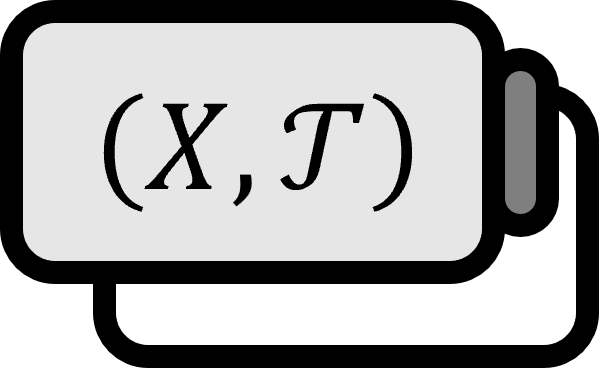A Compact Hausdorff Space is a Normal Space
Theorem 1
- [1]: A closed subset of a compact space is compact.
- [2]: A compact subset of a Hausdorff space is a closed set.
- [3]: For two compact subsets $A,B \subset X$ and $A \cap B = \emptyset$ of a Hausdorff space $X$, if $A \cap B = \emptyset$, there exists an open subset $U, V \subset X$ that satisfies: $$ A \subset U \\ B \subset V \\ U \cap V = \emptyset $$
- [4]: A compact Hausdorff space is a regular space.
Explanation
From Theorems [1] and [2], we can immediately see that compact subsets of a Hausdorff space are closed sets. Meanwhile, from Theorem [4], being compact is an additional condition to establish the converse of $T_{4} \implies T_{2}$.
Proof
[1]
For a compact space $X$, let $A \subset X$ be a closed set in $X$ and $\mathscr{O}$ be an open cover of $A$.
Since $A$ is a closed set, $\mathscr{O}’ : = \mathscr{O} \cup \left\{ X \setminus A \right\}$ is also an open cover of $X$. Since $X$ is compact, $$ A \subset X \subset \bigcup_{i=1}^{n} O_{i} $$ a finite open cover $\left\{ O_{i} \right\}_{i=1}^{n}$ exists. Therefore, $A$ is compact.
■
[2]
For a Hausdorff space $X$, let $A \subset X$ be compact, and $x \in X \setminus A$.
Since $X$ is a Hausdorff space, for every $y \in A$, there exists an open set $U_{y}, V_{y} \subset X$ that satisfies: $$ y \in U_{y} \\ x \in V_{y} \\ U_{y} \cap V_{y} = \emptyset $$ The compact subset $A$, for some $n \in \mathbb{N}$, satisfies: $$ A \subset \bigcup_{i=1}^{n} U_{y_{i}} $$ If we define the set $U, V$ as: $$ U := \bigcup_{i=1}^{n} U_{y_{i}} \\ \displaystyle V := \bigcap_{i=1}^{n} V_{y_{i}} $$ $U,V \subset X$ is an open set and $U \cap V = \emptyset$. Meanwhile, since $x \in V$ and $A \subset U$, $$ x \in V \subset (X \setminus U) \subset (X \setminus A) $$ Therefore, the union of all open sets $V \subset \left( X \setminus A \right)$, $\displaystyle \bigcup_{V \subset (X \setminus A)} V = X \setminus A$, is an open set, and $A$ is a closed set.
■
[3]
For a Hausdorff space $X$, let the compact subsets $A,B \subset X$ be $A \cap B = \emptyset$.
Then for $x \in B$, there exists an open set $U_{x}, V_{x} \subset X$ that satisfies: $$ A \subset U_{x} \\ x \in V_{x} \\ U_{x} \cap V_{x} = \emptyset $$ Moreover, $B$ is compact, so a $\left\{ x_{i} \right\}_{i=1}^{n}$ that satisfies $\displaystyle B \subset \bigcup_{i=1}^{n} V_{x_{i}}$ exists. If we define the set $U, V$ as: $$ U := \bigcap_{i=1}^{n} U_{x_{i}} \\ \displaystyle V := \bigcup_{i=1}^{n} V_{x_{i}} $$ then the open set $U, V$ satisfies: $$ U \cap V = \emptyset \\ A \subset U \\ B \subset V $$
■
[4]
For a compact Hausdorff space $X$, let $A,B \subset X$ be a subset of $X$ that is $A \cap B = \emptyset$.
Since $X$ is a compact space, $A,B \subset X$ is a compact subset, and by Theorem [2], $A,B$ is a closed subset in $X$. Moreover, since $X$ is a Hausdorff space, by Theorem [3], for the compact subset $A,B \subset X$, $$ A \subset U \\ B \subset V \\ U \cap V = \emptyset $$ there exists an open subset $U,V \subset X$. Therefore, $X$ is a regular space.
■
Meanwhile, from Theorems [1] and [2], we obtain the following corollary.
Corollary
For a compact Hausdorff space $X$, $A \subset X$ being a closed set in $X$ is equivalent to it being compact.
Munkres. (2000). Topology(2nd Edition): p165~167, 202. ↩︎
